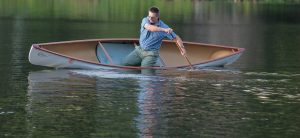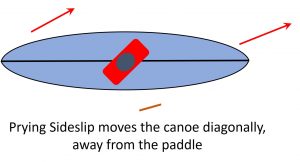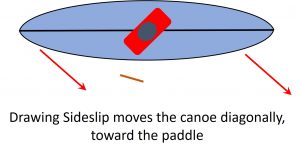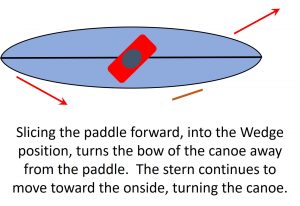By Tim Burris

I put together an interpretive routine that I called Sideslip Etude about five years ago. Tom McKenzie was the master of sideslips, but Tracy Hunt really enlightened me with the idea that sideslips can be used as initiations to any freestyle maneuver. I’m going to talk about this from the interpretive side, but I will eventually tie all the information into real world applications.
Just to review, a freestyle maneuver has three components. For simplicity’s sake, the initiation tells the back of the canoe which direction you want it to go (prys and sweeps are common initiations). The front of the canoe then rotates around a static paddle placement. Finally, the conclusion completes the maneuver with a stroke from the paddle placement to one end of the canoe.
If you need a refresher on sideslips, check out Paul Klonowski’s article at https://freestylecanoeing.com/solo-sideslips/ For my Sideslip Etude I did maneuvers in all four quadrants (forward, cross forward, reverse and cross reverse). Every maneuver was initiated by either a prying, or a drawing sideslips in three of the quadrants.
Let’s start with forward maneuvers. Christies, Axels, and Posts all turn the canoe towards the paddle side (or onside). We generally use a J stroke or a gentle stern pry to initiate those maneuvers. The static paddle is then placed onside with the correct angle, and the canoe rotates around it. We finish with a reverse sweep to the bow. The important part here is that the stern pry initiation tells the stern of the canoe to go away from our onside.
We can substitute the stern pry with a prying sideslip, because the prying sideslip moves the entire canoe away from our onside, and thus the stern is moving away from our paddle.

Once the prying sideslip is moving the canoe diagonally away from the paddle, you put your paddle parallel (neutral) to the keel and slice forward to a spot slightly ahead of the point of rotation, then open the paddle angle so that the front of the canoe turns,

and then rotates around your paddle. It can be either an axle or a post with the correct heel. With practice, you will get a feel about how much momentum you will need after the sideslip to perform the maneuver.
 To turn our canoe away from our paddle, we use a sweep to initiate a wedge, because the sweep pulls the rear of the canoe towards our onside. A drawing sideslip pulls the entire canoe in the same direction. Once the canoe is moving diagonally towards the paddle, we slice the neutral paddle forward to a spot slightly ahead of the point of rotation, and reverse the angle of the paddle blade so it pushes
To turn our canoe away from our paddle, we use a sweep to initiate a wedge, because the sweep pulls the rear of the canoe towards our onside. A drawing sideslip pulls the entire canoe in the same direction. Once the canoe is moving diagonally towards the paddle, we slice the neutral paddle forward to a spot slightly ahead of the point of rotation, and reverse the angle of the paddle blade so it pushes (wedges) the front of the canoe away from the paddle. This is a really fun sequence because the drawing sideslip carries more momentum into the maneuver, and the wedge demonstrates finesse.
(wedges) the front of the canoe away from the paddle. This is a really fun sequence because the drawing sideslip carries more momentum into the maneuver, and the wedge demonstrates finesse.
Because we use a sweep to initiate a cross axle or cross post, the drawing sideslip also works for these maneuvers. Likewise, any maneuver initiated with an onside J-stroke can be effectively initiated with a prying sideslip. Once you figure out the mechanics, then you can apply the same principles to all the other quadrants (cross forward, reverse, and cross reverse). Granted, it takes some practice to reach the point where your brain no longer needs to contemplate every paddle placement and angle. With practice, it becomes natural.
Now let’s apply this in everyday life.
Imagine canoeing in a narrow, slow-moving, twisty stream. Up ahead the stream turns sharply to your onside, but the creek is shallow on the inside of the curve, so you want to move over away from the shallow. You start with a prying sideslip to move into the middle of the stream. Just as you approach the bend, you slice your paddle forward in a neutral position and then open the angle as you would in an axle. You magically turn around the shallow bend. You probably won’t need the conclusion, so instead take a forward stroke to straighten out and position your canoe for the next turn. The sideslip positions your canoe ideally in the stream and the conversion of the sideslip into an axle turns you. This is an elegant way to negotiate the turn, but it is also very efficient because you use fewer paddle strokes to make the turn.
If the bend is to your offside you might initiate with a drawing sideslip and either apply a wedge, or a cross axle (or cross post) depending on which suits the turn the best. Many times, if I use the cross maneuver, I will take a couple cross-forward strokes after the turn, because it straightens out the canoe more quickly than switching over. Another reason for the cross-forward stroke is that often your onside is too close to the bank after the turn, and you may not have room to make an effective onside forward stroke.
*A note on heeling. Generally, we teach students to heel away from the paddle when doing drawing sideslips. The heel allows the canoe to ride up over the water instead of pushing it. Likewise, one normally heels toward the paddle on a prying sideslip. The problem comes when switching from an offside heel for the drawing sideslip to an onside heel for the wedge. The issue is that switching heels will rob momentum from your canoe -momentum that you need to perform the maneuver. One can actually sideslip with a flat boat – and do functional maneuvers with minimal heel. (So don’t overthink it.) I was able to do my Sideslip Etude with extreme heels because my canoe has a round bottom. I could roll the canoe from one side to the other with minimal loss of speed.
A really cool move is to paddle straight in (perpendicular) to a dock or landing. Apply a drawing sideslip and continue toward the landing. Apply a wedge a few yards (meters) before you reach your target. The wedge will turn your canoe parallel to the landing, but your momentum will carry you slowly right up to shore and you’ll step out with grace. This move takes a little practice to get the start point and timing perfected. But once you have it down, you’ll see jaws drop because it is such a cool, yet useful way of initiating a turn with a sideslip.
All of these maneuvers take practice. More importantly, you need to consider which sideslip to use with each maneuver. A sweep wouldn’t be the correct initiation for an axle or post. For that reason, it is not effective to perform an axle after a drawing sideslip, because the canoe is moving in the wrong direction to initiate the turn. With practice it becomes second nature and gives you efficient ways to turn on streams, as well as creative approaches to an interpretive routine.
Tracy Hunt rocked my world as to how much fun (and useful) sideslips can be. I hope you will have fun and try sideslips as initiations.